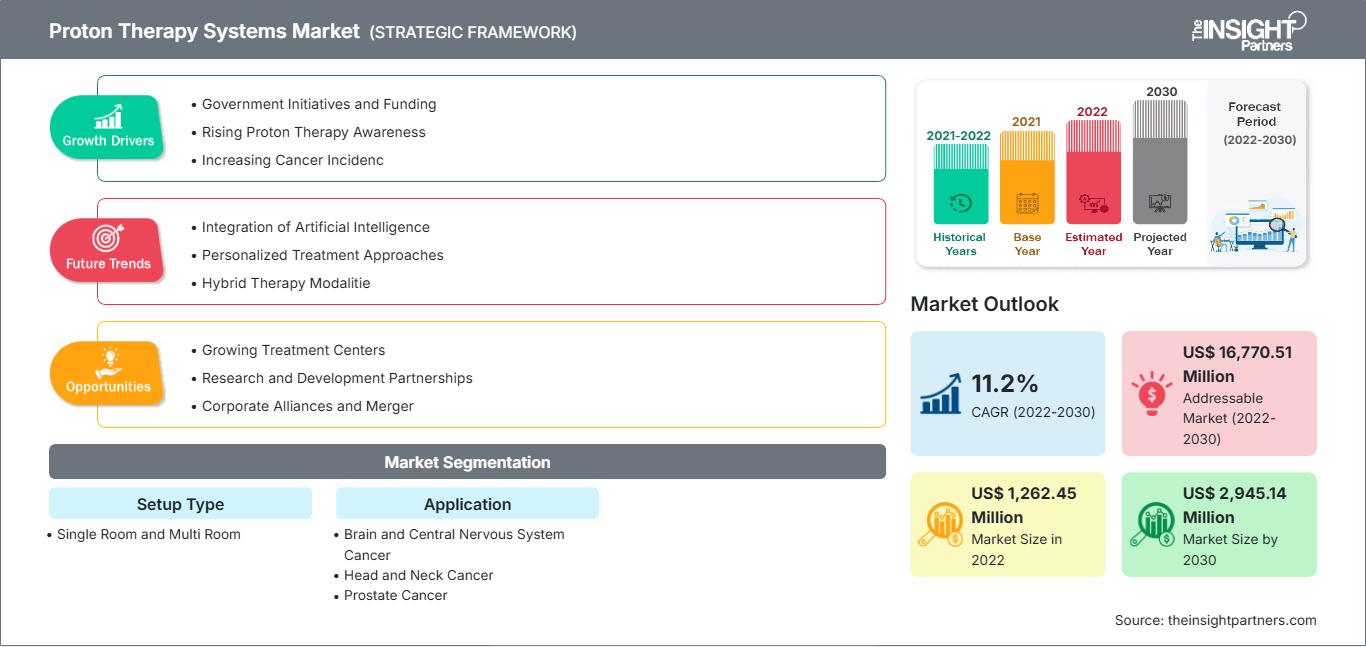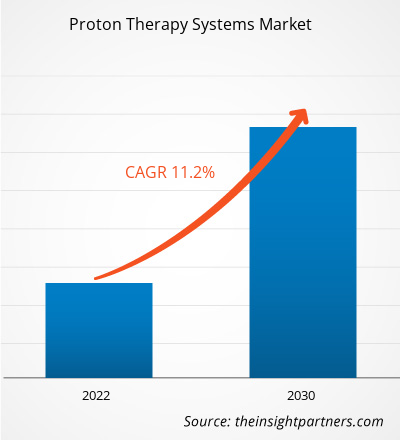[Informe de investigación] Se prevé que el mercado de sistemas de terapia de protones crezca de 1.262,45 millones de dólares estadounidenses en 2022 a 2.945,14 millones de dólares estadounidenses en 2030; se estima que registrará una tasa de crecimiento anual compuesta (TCAC) del 11,2 % durante el período 2022-2030.
Perspectivas del mercado y opinión de los analistas:
Las previsiones del mercado de sistemas de terapia de protones pueden ayudar a las partes interesadas en este mercado a definir sus estrategias de crecimiento.
Un sistema de terapia de protones es un dispositivo médico avanzado que proporciona un tratamiento de radiación de alta precisión para tumores. Estos sistemas son de gran tamaño y constan de un acelerador (ciclotrón), un sistema de transporte del haz, un sistema de selección de energía y un equipo de irradiación con pórtico giratorio. Debido a su eficacia en el tratamiento de ciertos tipos de cáncer, la demanda de terapia de protones ha aumentado en todo el mundo. Factores como la creciente demanda de tratamientos avanzados ante el aumento de la incidencia del cáncer y el mayor apoyo gubernamental a los centros de terapia de protones impulsan el crecimiento del mercado de sistemas de terapia de protones. Sin embargo, el alto costo y la gran superficie que requieren estos sistemas limitan dicho crecimiento. Además, se espera que la creciente adopción de tratamientos personalizados, junto con los avances tecnológicos, genere nuevas tendencias en el mercado de sistemas de terapia de protones en los próximos años.
Factores de crecimiento:
El aumento de la demanda de tratamientos avanzados ante el incremento de la incidencia del cáncer impulsa el crecimiento del mercado.
Según la Agencia Internacional para la Investigación del Cáncer (IARC), los cánceres de pulmón, mama y próstata presentaron la mayor incidencia en 2022. Estas enfermedades tienen una tasa estandarizada por edad de 23,6, 47,1 y 29,4 casos por cada 100.000 habitantes, respectivamente. De acuerdo con las estimaciones de la IARC, se prevé que el número total de casos de cáncer aumente de 19,98 millones en 2022 a 23,71 millones en 2030 y a 30,97 millones en 2045. Diversos tipos de cáncer, como los de cabeza y cuello (nasal, oral, ocular y laríngeo) y los cerebrales, requieren tratamientos específicos, lo que genera una alta demanda de enfoques terapéuticos avanzados, como la terapia de protones de intensidad modulada (IMPT). En las radioterapias tradicionales, como la radioterapia con rayos X, el tejido sano circundante al tumor también recibe radiación, lo que provoca efectos secundarios y puede causar cánceres secundarios. Sin embargo, la terapia de protones contribuye al tratamiento eficaz de tumores complejos en el cerebro y la región de la cabeza y el cuello, minimizando el daño colateral a los tejidos circundantes. Por consiguiente, la alta prevalencia del cáncer y la demanda de tratamientos avanzados impulsan la demanda de radioterapia basada en protones, lo que a su vez impulsa el crecimiento del mercado de sistemas de terapia de protones.
Obtendrá personalización gratuita de cualquier informe, incluyendo partes de este informe, análisis a nivel de país y paquetes de datos de Excel. Además, podrá aprovechar excelentes ofertas y descuentos para empresas emergentes y universidades.
Mercado de sistemas de terapia de protones: Perspectivas estratégicas

-
Obtenga las principales tendencias clave del mercado que se describen en este informe.Esta muestra GRATUITA incluirá análisis de datos, que abarcarán desde tendencias de mercado hasta estimaciones y pronósticos.
Restricción:
Sistemas de terapia de protones de alto coste y gran superficie
Un sistema de terapia de protones es un dispositivo médico avanzado utilizado en el tratamiento de tumores mediante radiación de alta precisión. Se trata de un equipo médico de gran tamaño que consta de un acelerador (ciclotrón), un sistema de transporte del haz, un sistema de selección de energía y un pórtico giratorio para la irradiación, lo que resulta en una gran superficie y un alto coste. Según la Universidad de Pensilvania (Oncolink), los ciclotrones de los sistemas de terapia de protones pesan hasta 200 toneladas y tienen un diámetro de entre 1,8 y 3,7 metros. El pórtico puede pesar 100 toneladas y tener un diámetro de 12 metros. Según un estudio publicado en 2021 en IOPscience, incluso el diseño compacto (configuración de una sola sala) requiere una superficie de 100 m², mientras que los sistemas de terapia de protones con varias salas ocupan entre 200 y 400 m².
Además, los sistemas de terapia de protones requieren una gran inversión de capital. Por ejemplo, un sistema de una sola sala puede costar entre 30 y 50 millones de dólares estadounidenses. El costo de los sistemas de protones multigantry puede partir de los 300 millones de dólares estadounidenses y, por lo general, solo se instalan en grandes hospitales y centros universitarios. Por lo tanto, los elevados requisitos de inversión y las grandes superficies de instalación son algunos de los factores que dificultan el crecimiento del mercado de sistemas de terapia de protones.
Segmentación y alcance del informe:
El análisis del mercado de sistemas de terapia de protones se ha llevado a cabo considerando los siguientes segmentos: tipo de configuración y aplicación.
Según el tipo de instalación, el mercado se divide en sistemas de una sola sala y sistemas multisala. El segmento de sistemas multisala ostentó una mayor cuota de mercado en sistemas de terapia de protones en 2022. Además, se prevé que el segmento de sistemas de una sola sala registre una tasa de crecimiento anual compuesto (TCAC) más rápida durante el período de pronóstico.
El mercado, según su aplicación, se clasifica en cáncer cerebral y del sistema nervioso central, cáncer de cabeza y cuello, cáncer de próstata, cáncer de mama, cáncer de pulmón, cáncer gastrointestinal y otros. El segmento de cáncer cerebral y del sistema nervioso central ostentó la mayor cuota de mercado de sistemas de terapia de protones en 2022 y se prevé que registre la mayor tasa de crecimiento anual compuesto (TCAC) durante el período de pronóstico.
Análisis regional:
En términos geográficos, el alcance del informe de mercado de sistemas de terapia de protones abarca Norteamérica, Europa, Asia Pacífico, Sudamérica y Centroamérica, y Oriente Medio y África. En 2022, Norteamérica representó la mayor cuota de mercado. La creciente aceptación e implementación de los dispositivos médicos más recientes, la alta prevalencia del cáncer y las innovaciones de producto de los principales actores contribuyen a la expansión del mercado de sistemas de terapia de protones en Norteamérica. Según estimaciones de la Sociedad Americana Contra El Cáncer, Estados Unidos registró aproximadamente 1,95 millones de nuevos casos de cáncer y 0,61 millones de muertes relacionadas con la enfermedad en 2023, lo que supone un aumento significativo con respecto a los 1,6 millones de casos de cáncer y 0,6 millones de muertes notificadas en 2020. De acuerdo con el Grupo Cooperativo de Terapia de Partículas, a finales de 2023, Estados Unidos contaba con el mayor número de sistemas de terapia de protones a nivel mundial, con 46 centros de tratamiento.
Perspectivas regionales del mercado de sistemas de terapia de protones
Los analistas de The Insight Partners han explicado en detalle las tendencias y los factores regionales que influyen en el mercado de sistemas de terapia de protones durante el período de previsión. Esta sección también analiza los segmentos y la geografía del mercado de sistemas de terapia de protones en Norteamérica, Europa, Asia Pacífico, Oriente Medio y África, y Sudamérica y Centroamérica.
Alcance del informe de mercado de sistemas de terapia de protones
| Atributo del informe | Detalles |
|---|---|
| Tamaño del mercado en 2022 | 1.262,45 millones de dólares estadounidenses |
| Tamaño del mercado para 2030 | US$ 2.945,14 millones |
| Tasa de crecimiento anual compuesto global (2022 - 2030) | 11,2% |
| Datos históricos | 2021-2022 |
| período de previsión | 2022-2030 |
| Segmentos cubiertos |
Por tipo de configuración
|
| Regiones y países cubiertos |
América del norte
|
| Líderes del mercado y perfiles de empresas clave |
|
Densidad de los actores del mercado de sistemas de terapia de protones: comprensión de su impacto en la dinámica empresarial
El mercado de sistemas de terapia de protones está creciendo rápidamente, impulsado por la creciente demanda de los usuarios finales debido a factores como la evolución de las preferencias de los consumidores, los avances tecnológicos y una mayor conciencia de los beneficios del producto. A medida que aumenta la demanda, las empresas amplían su oferta, innovan para satisfacer las necesidades de los consumidores y aprovechan las tendencias emergentes, lo que impulsa aún más el crecimiento del mercado.

- Obtenga una visión general de los principales actores del mercado de sistemas de terapia de protones.
Desarrollos de la industria y oportunidades futuras:
A continuación se enumeran algunos desarrollos estratégicos de los principales actores que operan en el mercado de sistemas de terapia de protones, según los comunicados de prensa de las empresas:
- En enero de 2024, OncoRay lanzó el prototipo de un sistema de terapia de protones guiado por resonancia magnética (RM) de cuerpo entero para el seguimiento en tiempo real de tumores en movimiento mediante imágenes de resonancia magnética (RM) durante la terapia. La RM facilita la visualización de los tumores con un contraste mejorado, lo que supone su principal ventaja frente a las técnicas de imagen convencionales. Un mayor contraste permite delimitar mejor el tumor del tejido sano circundante y definir con mayor precisión el volumen a irradiar.
- En diciembre de 2023, HKSH Medical Group inauguró un nuevo centro de terapia de protones en el HKSH Eastern Medical Centre de A Kung Ngam, Shau Kei Wan, Hong Kong. El nuevo centro cuenta con un avanzado sistema de terapia de protones y dos salas de tratamiento de última generación. El sistema incluye dos pórticos de terapia de protones semirrotatorios, el sistema de transporte de haz más moderno y un acelerador basado en sincrotrón.
Panorama competitivo y empresas clave:
Varian Medical Systems Inc., Sumitomo Heavy Industries Ltd., Hitachi Ltd., Ion Beam Applications SA, Mevion Medical Systems, Provision Healthcare LLC, ProTom International, Optivus Proton Therapy Inc., Advanced Oncotherapy plc y B dot Medical Inc. figuran entre las empresas más destacadas analizadas en el informe de mercado de sistemas de terapia de protones. Estas empresas se centran en el desarrollo de nuevas tecnologías, la mejora de los productos existentes y la expansión de su presencia geográfica para satisfacer la creciente demanda mundial.
- Análisis histórico (2 años), año base, pronóstico (7 años) con CAGR
- Análisis PEST y FODA
- Tamaño del mercado, valor/volumen: global, regional y nacional
- Industria y panorama competitivo
- Conjunto de datos de Excel
Informes recientes
Testimonios
Razón para comprar
- Toma de decisiones informada
- Comprensión de la dinámica del mercado
- Análisis competitivo
- Información sobre clientes
- Pronósticos del mercado
- Mitigación de riesgos
- Planificación estratégica
- Justificación de la inversión
- Identificación de mercados emergentes
- Mejora de las estrategias de marketing
- Impulso de la eficiencia operativa
- Alineación con las tendencias regulatorias






















 Obtenga una muestra gratuita para - Mercado de sistemas de terapia de protones
Obtenga una muestra gratuita para - Mercado de sistemas de terapia de protones